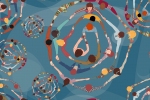May 12, 2014
The Tragic Gap
 On Sunday, Emily Scott, the pastor of St. Lydia’s, preached a sermon about “standing in the tragic gap,” a phrase that comes from Parker Palmer, and a reminder that we must stand in the space between idealism and cynicism. Palmer sums it up well in an interview in the Sun.
On Sunday, Emily Scott, the pastor of St. Lydia’s, preached a sermon about “standing in the tragic gap,” a phrase that comes from Parker Palmer, and a reminder that we must stand in the space between idealism and cynicism. Palmer sums it up well in an interview in the Sun.
"By the tragic gap I mean the gap between the hard realities around us and what we know is possible — not because we wish it were so, but because we’ve seen it with our own eyes. For example, we see greed all around us, but we’ve also seen generosity. We hear a doctrine of radical individualism that says, “Everyone for him- or herself,” but we also know that people can come together in community and make common cause.
"As you stand in the gap between reality and possibility, the temptation is to jump onto one side or the other. If you jump onto the side of too much hard reality, you can get stuck in corrosive cynicism. You game the economic system to get more than your share, and let the devil take the hindmost. If you jump onto the side of too much possibility, you can get caught up in irrelevant idealism. You float around in a dream state saying, “Wouldn’t it be nice if . . . ?” These two extremes sound very different, but they have the same impact on us: both take us out of the gap — and the gap is where all the action is."
We are all aware of the daunting problems that face us: from climate change to poverty, a bloated prison population, and war. In light of this, it is tempting to give in to cynicism, giving up hope that anything we do can have a real impact, and therefore resigning ourselves to doing nothing at all. Or it is tempting to hold on to an unrealistic idealism, hoping for a change that never comes and never engaging with the world as it really is. Either extreme leads to stagnation and burnout.
Palmer goes on to say that effectiveness is secondary to faithfulness. “I mean being true to my own gifts,” he says, “true to my perception of the world’s needs, and true to those points where my gifts and those needs intersect.”
In my own, limited experience, I find that I feel most at peace when I simply step out in faithfulness and get to work. I have to let go of the need to have a clear vision of how things will work out in the end, a fool-proof plan for success, or a fully developed theology, and instead act and connect. I attend a meeting, get involved with people trying to make a difference, or ask questions and learn as much as I can.
It’s easy to become paralyzed and overwhelmed, but I also believe that disengagement and apathy are sins. As people and communities of faith, we are called to live and work in that tragic gap, because that’s where we find a real hope and that’s where change happens.
Are you or your community standing in the tragic gap? What’s taking place there?





